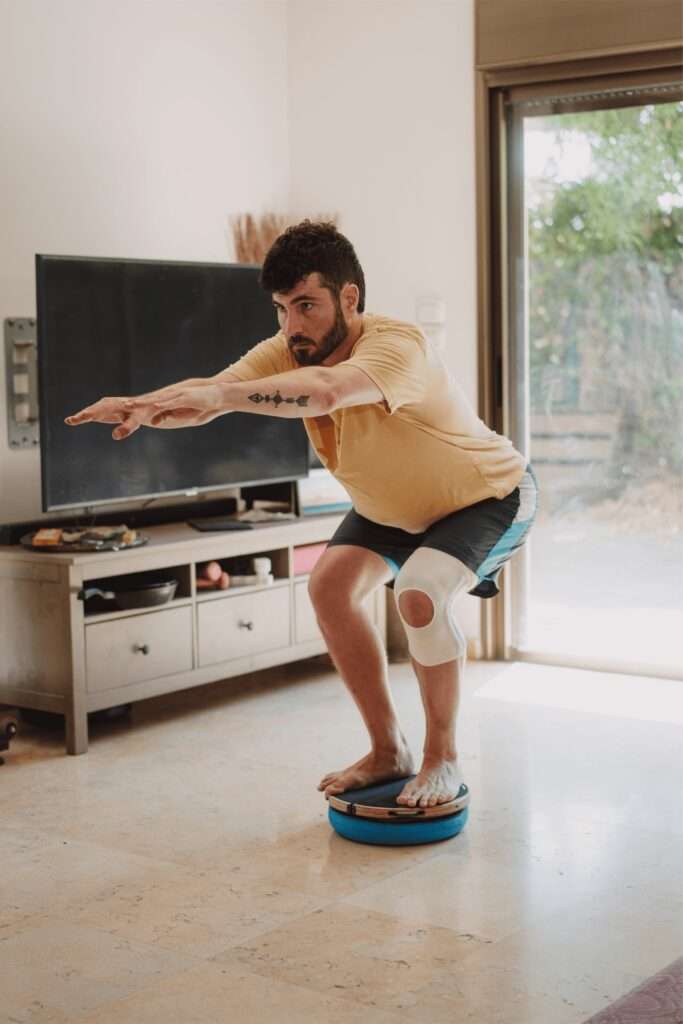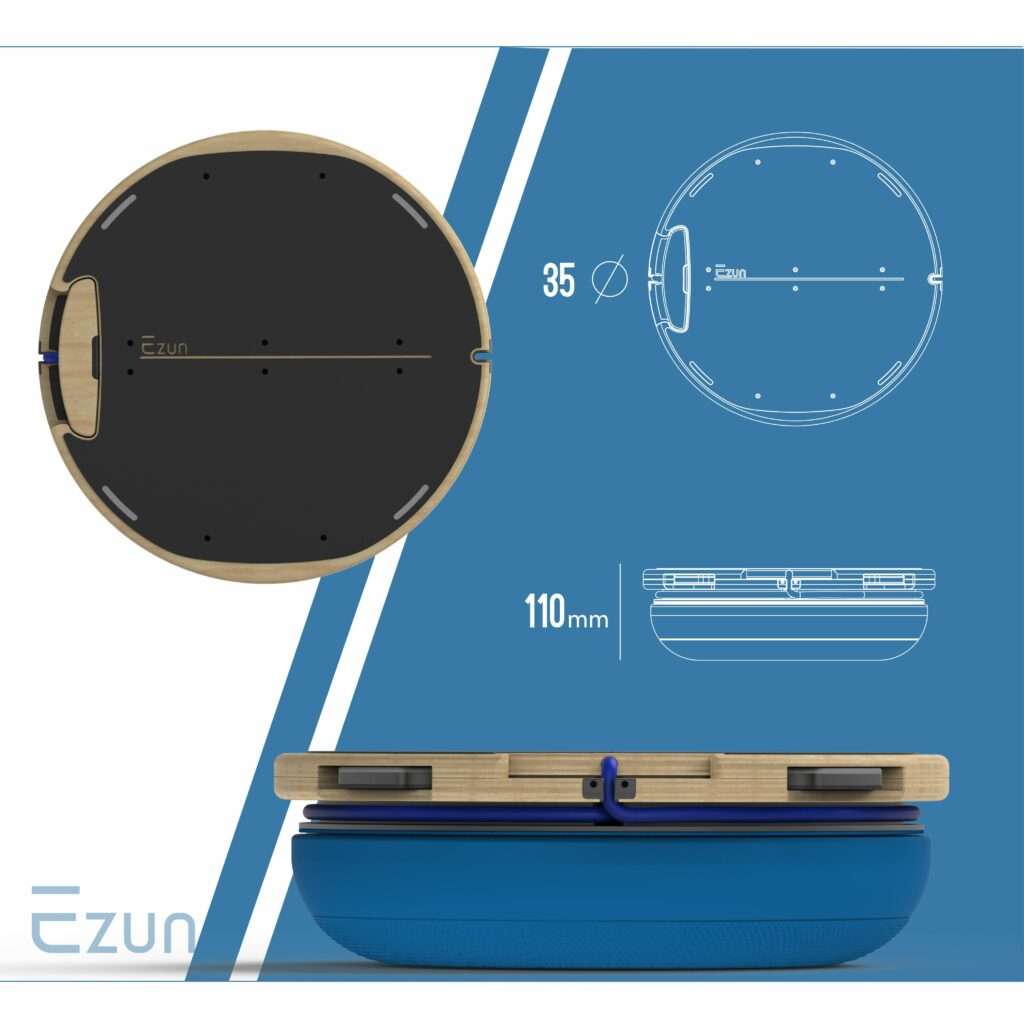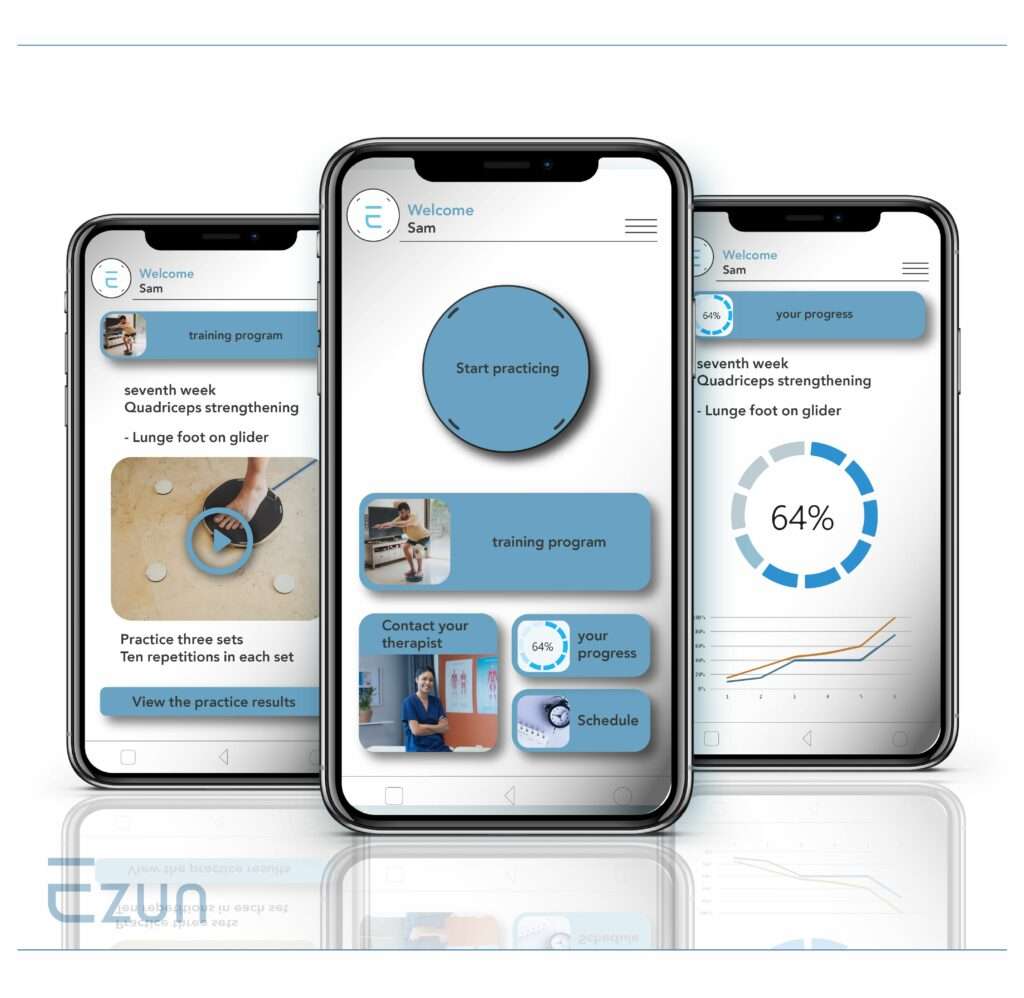Welcome to an exclusive interview with Soof Azani, a talented student from the Holon Institute of Technology who has recently won the FIT Sport Design Award for his innovative creation, EZUN, and has been named the Emerging Sport Gear Designer of the Year. EZUN is an innovative concept designed to revolutionize physical rehabilitation for knee and ankle injuries, providing a smart training surface that combines modern technology with an engaging user experience.
Under the guidance of Professor Ofer Zik, Soof has transformed his personal challenges into a project that promises to make a significant impact on the lives of many. Today, we delve into his academic journey, the inspiration behind EZUN, and the development process that brought this concept to life.

Can you tell us about your academic journey and personal background?
Hello, my name is Soof Azani, a 29-year-old industrial designer living in Tel Aviv. In my personal life, I am a big fan of the sea, balance, and music. I grew up in a house filled with a sporting spirit, musical instruments, and a love for simplicity and creativity.
What motivated you to choose design as a field of study?
I started my journey in the world of design in my father’s workshop. My father is a talented graphic artist and craftsman with many technical skills. As a child, I would accompany him to work, learning how to work with my hands. I loved seeing my paintings and drawings come to life. I worked with wood and other materials in the workshop, and over time, I realized that this was the field I wanted to study.
When I began my studies at the Holon Institute of Technology, I felt like I was in my element. I significantly expanded my knowledge of drawing and working techniques, art, and craft, and slowly began to understand what design really is. During my studies, I always pushed my limits and wasn’t always the easiest student for my lecturers, but in the end, the results spoke for themselves. After the first year, the workshop felt like my comfortable place. Later, I realized that I enjoyed developing small and large mechanisms, fell in love with working with ceramics, and was drawn to the world of interactive experience. In the third year of my studies, I participated in a student exchange at MOME in Budapest. The exchange experience was empowering and broadened my horizons.
What inspired you to create Ezun and how did your personal interests influence its design?
Sports and the health of the body and mind have always been important to me. When I say sports, I don’t mean football or basketball. As a child, I trained in floor gymnastics and capoeira. In my youth, I started surfing and later got into skateboarding, slacklining, and boulder climbing, all of which require a significant amount of balance.
In the middle of my degree, I had a scooter accident where I tore a cruciate ligament and the meniscus in my left leg. This injury accompanied me for a long time, causing not only physical pain but also a lot of internal pain. I felt like I wasn’t myself without the sports that defined my daily life. This led me to an in-depth personal introduction to the world of physiotherapy, which replaced the physical activities I was engaged in. The main problem was that it was painful, boring, and exhausting. A year after the injury, I was asked to think about a topic for my final project. I knew I wanted to design a technological product that would apply the research and experience design skills I had acquired during my degree, alongside formal expression. The idea of EZUN was born from a combination of passion and frustration. Understanding that as a designer, I could create a completely different rehabilitation experience than the one I and thousands of other people had experienced is what drew me to develop the product.


Can you tell us about the development process of Ezun? How did you come up with the design features, and what influenced your choice of materials?
The development process started with three months of research where I focused on formulating the idea and understanding its context. I met with many physiotherapists with different treatment approaches, patients with various injuries, and tried to understand the most common injuries and the demographics they affected. The goal was to identify where such a product could have the most impact.
Simultaneously, I deepened my knowledge in the world of experience design and the field of “gamification.” Over time, things began to clarify. After focusing the project on knee and ankle injuries, I could start thinking about functionality. This phase was very busy. I tested a variety of exercises and rehabilitation products with different functions. By classifying the exercises and devices used, I could see where there were overlaps and which functions were necessary in the rehabilitation process. Eventually, I was left with a list of exercises, devices, and functions that formed the initial framework for the product. The functions required by the patient guided the shape and position of the pieces, and I worked hard to find appropriate dimensions that would serve the product’s original values. The design of the experience and the interface with the product was a parallel process. I reviewed existing products in the market to understand what worked and what didn’t. I aspired for the product to function independently of others. The materials and shapes of the product were inspired by the world of balance and rehabilitation training devices. Although the product is loaded with options, I tried to keep a simple look that is slightly sporty and comforting, giving a sense of security and stability.
What were some of the biggest challenges you faced while developing Ezun?
The most challenging step in the process was selecting the functions. There were so many options, and it always felt like more could be added to perfect the rehabilitation process. It took time, but I can confidently say that everything in the product is necessary and valuable for the patient.
Rehabilitation supplies and therapists are plentiful, but the main problem I identified was motivation in the home environment. At the beginning of rehabilitation, most patients are highly motivated but don’t understand how much time it requires. After the midpoint of rehabilitation, when it’s already possible to move relatively freely, there’s a feeling that the hard part is over. However, this is actually the most dangerous part because the potential for injury is higher than ever, and motivation starts to wane. The motivation problem can be identified in several other areas of our lives, like working long hours, studying, and more. One useful way to solve it is through “play.” The field of gamification has developed significantly in recent years, and you can see more actions designed to encourage us to play or receive rewards similar to winning a game. This method of reward can naturally motivate users to perform actions perceived as difficult, frustrating, or painful, and they will even enjoy it because the reward outweighs the hardship.

You’ve added modern technologies to Ezun’s design, such as motion sensors and an app, can you explain the role they have in the user’s experience?
To establish a system that rewards the user with positive feedback, follow-up, and close guidance that advances the patient each time, I used two types of sensors. The first system is the feedback system, with a gyroscope sensor and motion analysis recording capabilities that allow the patient to monitor their rehabilitation, see progress, set personal records, and receive detailed instructions on the exercises. The second system is the communication system, featuring four light bulbs that form the playful heart of EZUN. This actively motivates the user, presenting new challenges and possibilities. The bulbs enhance the usability of the product, allowing users the freedom to practice independently while maintaining dynamism and accuracy. The Izon application serves as the operating center, issuing commands before practice and collecting relevant information during the exercises.
Congratulations on winning the FIT Sport Design Award! How does it feel to receive this award, and what impact do you envision it having on your career?
As a young designer who just graduated, winning the competition was the greatest gift I could have hoped for. The news that I was evaluated so positively by designers with professional experience from around the world is incredibly exciting. I want to take this opportunity to express my gratitude for their evaluation and time.
Balance, as a research process and a product, is no longer just a final project in my design studies. It is a concept project that is now traveling around the world, hoping to make a significant impact in its field.
Lastly, what do you envision your future looking like? If you could work on any project, with any team, or anywhere, what would you choose and why?
As a designer, I believe it is essential to always listen and observe, letting ideas emerge, even the most absurd ones, and allowing myself to experiment. This approach has led me to my next venture: designing the listening experience. This design project in the world of sound, developed with a small, hardworking, and ambitious team, involves researching materials, qualities, and interesting combinations of senses to create a unique listening experience.
Sports and music are major areas of interest in my life, and I intend to pursue opportunities in these fields. As a designer in Israel, there is a clear glass ceiling in these areas, so I aspire to travel the world to learn, listen, and work towards the future of these fields.










